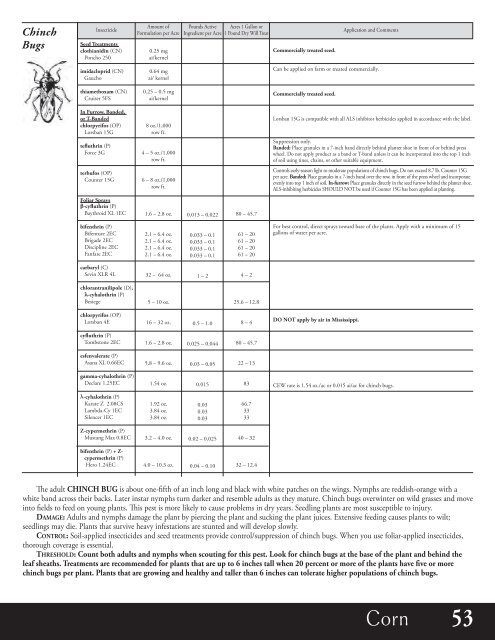Agronomic Crops
mJyPrJ
mJyPrJ
Create successful ePaper yourself
Turn your PDF publications into a flip-book with our unique Google optimized e-Paper software.
Chinch<br />
Bugs<br />
Insecticide<br />
seed treatments<br />
clothianidin (CN)<br />
Poncho 250<br />
imidacloprid (CN)<br />
Gaucho<br />
Amount of<br />
Formulation per Acre<br />
0.25 mg<br />
ai/kernel<br />
0.64 mg<br />
ai/ kernel<br />
Pounds Active<br />
Ingredient per Acre<br />
Acres 1 Gallon or<br />
1 Pound Dry Will Treat<br />
Commercially treated seed.<br />
Application and Comments<br />
Can be applied on farm or treated commercially.<br />
thiamethoxam (CN)<br />
Cruiser 5FS<br />
0.25 – 0.5 mg<br />
ai/kernel<br />
Commercially treated seed.<br />
In Furrow, Banded,<br />
or t-Banded<br />
chlorpyrifos (OP)<br />
Lorsban 15G<br />
tefluthrin (P)<br />
Force 3G<br />
8 oz./1,000<br />
row ft.<br />
4 – 5 oz./1,000<br />
row ft.<br />
Lorsban 15G is compatible with all ALS inhibitor herbicides applied in accordance with the label.<br />
Suppression only.<br />
Banded: Place granules in a 7-inch band directly behind planter shoe in front of or behind press<br />
wheel. Do not apply product as a band or T-band unless it can be incorporated into the top 1 inch<br />
of soil using tines, chains, or other suitable equipment.<br />
terbufos (OP)<br />
Counter 15G<br />
6 – 8 oz./1,000<br />
row ft.<br />
Controls early-season light to moderate populations of chinch bugs. Do not exceed 8.7 lb. Counter 15G<br />
per acre. Banded: Place granules in a 7-inch band over the row, in front of the press wheel and incorporate<br />
evenly into top 1 inch of soil. In-furrow: Place granules directly in the seed furrow behind the planter shoe.<br />
ALS-inhibiting herbicides SHOULD NOT be used if Counter 15G has been applied at planting.<br />
Foliar sprays<br />
b-cyfluthrin (P)<br />
Baythroid XL 1EC<br />
1.6 – 2.8 oz.<br />
0.013 – 0.022<br />
80 – 45.7<br />
bifenthrin (P)<br />
Bifenture 2EC<br />
Brigade 2EC<br />
Discipline 2EC<br />
Fanfare 2EC<br />
2.1 – 6.4 oz.<br />
2.1 – 6.4 oz.<br />
2.1 – 6.4 oz.<br />
2.1 – 6.4 oz.<br />
0.033 – 0.1<br />
0.033 – 0.1<br />
0.033 – 0.1<br />
0.033 – 0.1<br />
61 – 20<br />
61 – 20<br />
61 – 20<br />
61 – 20<br />
For best control, direct sprays toward base of the plants. Apply with a minimum of 15<br />
gallons of water per acre.<br />
carbaryl (C)<br />
Sevin XLR 4L<br />
32 – 64 oz.<br />
1 – 2<br />
4 – 2<br />
chlorantranilipole (D),<br />
λ-cyhalothrin (P)<br />
Besiege<br />
5 – 10 oz.<br />
25.6 – 12.8<br />
chlorpyrifos (OP)<br />
Lorsban 4E<br />
16 – 32 oz.<br />
0.5 – 1.0<br />
8 – 4<br />
Do not apply by air in Mississippi.<br />
cyfluthrin (P)<br />
Tombstone 2EC<br />
1.6 – 2.8 oz.<br />
0.025 – 0.044<br />
80 – 45.7<br />
esfenvalerate (P)<br />
Asana XL 0.66EC<br />
5.8 – 9.6 oz.<br />
0.03 – 0.05<br />
22 – 13<br />
gamma-cyhalothrin (P)<br />
Declare 1.25EC<br />
1.54 oz.<br />
0.015<br />
83<br />
CEW rate is 1.54 oz./ac or 0.015 ai/ac for chinch bugs.<br />
λ-cyhalothrin (P)<br />
Karate Z 2.08CS<br />
Lambda-Cy 1EC<br />
Silencer 1EC<br />
1.92 oz.<br />
3.84 oz.<br />
3.84 oz.<br />
0.03<br />
0.03<br />
0.03<br />
66.7<br />
33<br />
33<br />
Z-cypermethrin (P)<br />
Mustang Max 0.8EC<br />
3.2 – 4.0 oz.<br />
0.02 – 0.025<br />
40 – 32<br />
bifenthrin (P) + Z-<br />
cypermethrin (P)<br />
Hero 1.24EC<br />
4.0 – 10.3 oz.<br />
0.04 – 0.10<br />
32 – 12.4<br />
e adult CHInCH BUG is about one-fifth of an inch long and black with white patches on the wings. Nymphs are reddish-orange with a<br />
white band across their backs. Later instar nymphs turn darker and resemble adults as they mature. Chinch bugs overwinter on wild grasses and move<br />
into fields to feed on young plants. is pest is more likely to cause problems in dry years. Seedling plants are most susceptible to injury.<br />
DAMAGe: Adults and nymphs damage the plant by piercing the plant and sucking the plant juices. Extensive feeding causes plants to wilt;<br />
seedlings may die. Plants that survive heavy infestations are stunted and will develop slowly.<br />
ContRoL: Soil-applied insecticides and seed treatments provide control/suppression of chinch bugs. When you use foliar-applied insecticides,<br />
thorough coverage is essential.<br />
tHResHoLD: Count both adults and nymphs when scouting for this pest. Look for chinch bugs at the base of the plant and behind the<br />
leaf sheaths. treatments are recommended for plants that are up to 6 inches tall when 20 percent or more of the plants have five or more<br />
chinch bugs per plant. Plants that are growing and healthy and taller than 6 inches can tolerate higher populations of chinch bugs.<br />
Crop Name Corn 53


